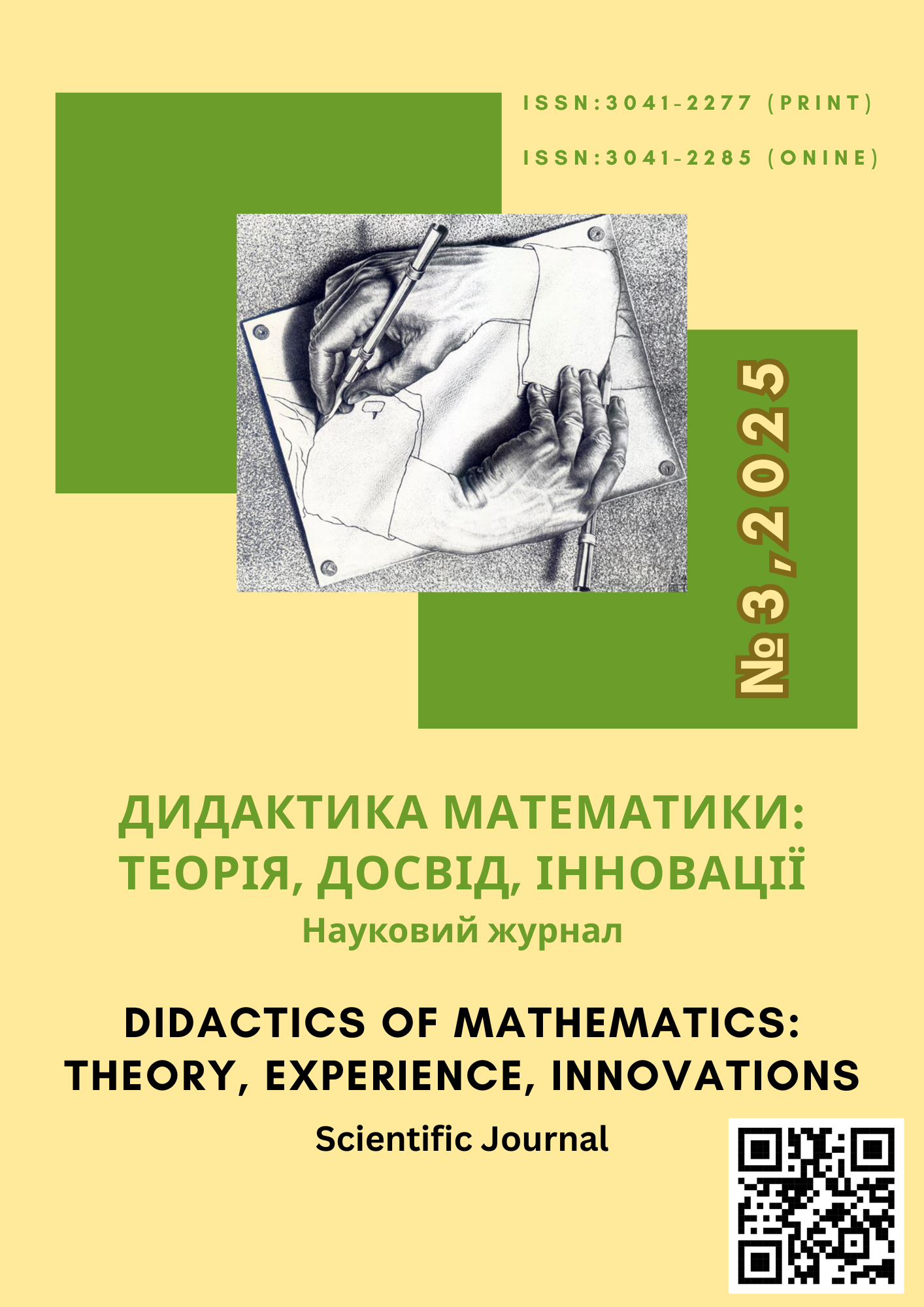Formation of stereometric culture of future mathematics teachers
https://doi.org/10.31652/3041-2277-2025-3-67-76Published 2025-07-15
Keywords
- geometry teaching,
- future mathematics teachers,
- stereometric problem,
- competence
Copyright (c) 2025 Ольга Матяш, Андрій Матяш

This work is licensed under a Creative Commons Attribution 4.0 International License.
How to Cite
Abstract
The article explains the relevance of the problem of forming the stereometric culture of future mathematics teachers and considers some ways to address it. Modern requirements for teaching stereometry in schools arise from new perspectives on the goals and conditions of personality development in the digital society. One of the pressing contemporary issues is the formation of future mathematics teachers' ability to effectively teach stereometry and to utilize the specific features of this course to develop students’ thinking and mathematical competence.
The article highlights the insufficient number of publications on the methodological preparation of future mathematics teachers to teach geometry, particularly stereometry. The competence-based approach to teacher training — focused on developing geometric-methodical literacy, pedagogical convictions, and methodological experience — necessitates the activation of students' educational and cognitive activities and the encouragement of their full potential in teaching practice. There is a clear need to expand the conditions for developing the geometric culture of future mathematics teachers. Among such conditions, we consider the inclusion of special mandatory and elective courses aimed at developing a high level of skill in solving stereometric problems of any level of complexity. The paper presents the experience of teaching additional courses to students: Practicum on Solving Stereometric Problems and Theory and Methods of Teaching Stereometry in Academic Lyceums.
Downloads
References
- Глазова, В. В., & Горзова, С. А. (2017). GeoGebra – інноваційний засіб для вивчення стереометрії. Збірник наукових праць фізико-математичного факультету ДДПУ.
- Кірман, В., & Харлаш, Л. (2020). Формування готовності вчителів математики навчати проведення обґрунтувань у стереометричних задачах. Вісник післядипломної освіти: Збірник наукових праць. Серія «Педагогічні науки», 12(41). https://ojs.uem.edu.ua/index.php/vpo/article/view/146/349
- Лисенко, П. С. (2021). Формування в учнів уміння розв’язувати стереометричні задачі на тіла обертання. У Актуальні проблеми природничих і гуманітарних наук у дослідженнях молодих учених «Родзинка – 2021» (с. 607–608).
- Матяш, О. І., Ясінський, В. А., & Прус, А. В. (2010). Формування знань старшокласників про різні методи розв’язування задач стереометрії. Математика в школі, (10), 8–17.
- Матяш, О. І. (2013). Конструювання систем задач у навчанні учнів геометрії в старшій школі. У Особистісно орієнтоване навчання математики: сьогодення і перспективи (с. 7–9). ТОВ «АСМІ».
- Матяш, О. І., & Березюк, Т. П. (2006). Система задач на урок як засіб формування знань та умінь учнів з геометрії. ВДПУ.
- Матяш, О. І., Воєвода, А. Л., Михайленко, Л. Ф., Наконечна, Л. Й., & Коношевський, О. Л. (2020). Методика навчання геометрії в школі. Практикум: навчально-методичний посібник. ТВОРИ.
- Матяш, О. І. (2013). Теоретико-методичні засади формування методичної компетентності майбутнього вчителя математики до навчання учнів геометрії (Монографія). ФОП Легкун В. М.
- Міністерство освіти і науки України. (2024). Професійний стандарт «Вчителя закладу загальної середньої освіти». https://mon.gov.ua/npa/pro-zatverdzhennia-profesiinoho-standartu-vchytel-zakladu-zahalnoi-serednoi-osvity
- Міністерство освіти і науки України. (2024). Навчальні програми для 10–11 класів. Математика. Профільний рівень. https://mon.gov.ua/osvita-2/zagalna-serednya-osvita/osvitni-programi/navchalni-programi-dlya-10-11-klasiv
- Український центр оцінювання якості освіти. (2019). Звіт про проведення зовнішнього незалежного оцінювання у 2019 році (Том 2). https://nus.org.ua/wp-content/uploads/2019/08/ZVIT-ZNO_2019-Tom_2.pdf
- Філон, Л. Г. (2018). Професійна спрямованість навчання стереометрії учнів старшої профільної школи. Вісник Черкаського національного університету імені Богдана Хмельницького. Серія: Педагогічні науки, (16). https://ped-ejournal.cdu.edu.ua/article/view/2419

